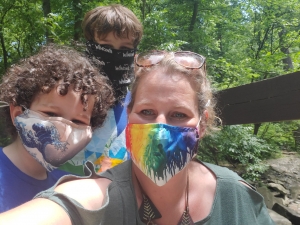Next week marks the one-year anniversary of NIH shifting to maximum telework in response to the COVID-19 pandemic. Like employers and employees across the country, overnight we needed to adapt our entire enterprise and reinvent our jobs in the virtual workplace. Coincidentally, next week is also when with a deep breath and a big hug, I send my six year old back to school in person, masked up and excited to meet his 1st grade teacher in person for the first time. So it seems like a good time to reflect on what the past year has been like, juggling the demands of serving in the leadership of a government agency square in the middle of COVID response with the needs of two young children during this nationwide experiment in virtual schooling.
Over the past year, I have gotten expert at the hand-over-the-mouth side conversations with my kids while muted on videoconference. There are good days and there are bad days. Like when my already prone-to-anxiety fifth grader gets hysterical because there are technology glitches and is panicked he’s missed something. Or when my first grader breaks down into tears because he’s had to sit in front of a computer for hours and is confused by something being asked of him. Inevitably, these moments occur when I’m in the middle of a critical meeting. I’ve accidentally come off mute while in the middle of alternately yelling at and bribing my children to behave so I can just pay attention to this conversation. I long for five minutes to just pay sole attention to the work I am doing and not have to think about snack time or lunch options or whether trombone is starting to whether a Chromebook is charged. I struggle to feel smart and competent as either a mother or as a professional when the unrelenting demands of one are constantly competing with the other.
Much to the entertainment of my colleagues, I have found my six year old does best when I am working nearby, which means he is constantly in the background of my WebEx or Zoom – fidgeting, coloring, doing jumping jacks – as I try to provide intelligent advice on agency policy with a song about counting frogs in one ear. I have been caught frozen in moments of indecision, as my children come running up in hysterical tears for help with one thing or another, but I have an upcoming item on the agenda to speak to. And that’s the curated account – not delving into the darker moments when I break down in tears or lose my temper because I reached the limits of my emotional wherewithal and snap at my kids in a voice I barely recognize as my own. Or those days when I have trouble caring about what’s going on at work or just turn my children over to electronic devices for a moment of peace. I worry all the time that having my children continually visible in my workspace, demonstrating my constant state of distraction, will cause my (primarily older and male) colleagues to take me less seriously.
The media has offered extensive coverage of how truly difficult this balancing act has been, the disproportionate effect it is having on women or individuals whose jobs do not support telework, such as healthcare workers or front-line service providers, and the agonizing choice faced by many parents struggling with impossible dilemmas of keeping themselves or their loved ones safe from a deadly disease while trying to do what’s best for their child’s well-being and education. The wrench the pandemic has thrown into the everyday tension of work-life balance just doesn’t affect women, of course. In my own household, my husband has taken on more childcare responsibilities than ever, as the pandemic has increased my workload, and a recent Pew study seems to indicate this is happening all over the country1. But evidence has long shown that women bear a disproportionate burden of household and dependent care responsibilities2, and the early data on the negative impact of the pandemic on the productivity of women in science is truly alarming3. There is recognition across the biomedical enterprise that the long-term impact of the pandemic could entail a devastating setback for women and others with dependent care responsibilities, and there are a lot of discussions of strategies to minimize that risk.
In a world currently experiencing staggering loss of life and economic misfortune due to COVID-19, my challenges pale by comparison. My family has been able to stay safe, we are healthy, we are employed… and yet still it is a struggle. Even as it feels like hope is on the horizon, in the form of vaccine and falling hospitalization rates and opening of schools, we must recognize not just the toll the past year has taken on working women and parents, but also not lose sight of the bright light the pandemic has cast on this balancing act. The challenge of balancing work and caregiving doesn’t go away just because it isn’t visible on Zoom. We need to create an environment that feels safe for caregivers, particularly women, to talk about their real-world dilemmas and ask for help or just feel empathy from their peers, without feeling like revealing this diminishes us as professionals. I thought long and hard about writing such a personal blog post, but I worry that by not talking candidly and honestly about how difficult juggling this all is, I am serving as a bad role model. The working mom dilemma exists in the best of time, as author Amy Westfield describes it “We expect women to work like they don’t have children, and raise children as if they don’t work.”
I am not going to end this blog post with a pithy solution that diminishes the complexity of the problem or suggests I personally have this all figured out. The next few years will undoubtedly be dominated by a “lessons learned” conversation about COVID 19, and I plan to use my seat at the table of scientific leadership to make sure we haven’t squandered a crisis for women in science. I hope other leaders, both men and women, will do the same.
1 https://www.pewresearch.org/fact-tank/2020/10/22/fewer-mothers-and-fathers-in-u-s-are-working-due-to-covid-19-downturn-those-at-work-have-cut-hours/
2 https://www.forbes.com/sites/maggiegermano/2019/03/27/women-are-working-more-than-ever-but-they-still-take-on-most-household-responsibilities/?sh=71bbae5e52e9
3 https://www.scientificamerican.com/article/women-in-science-may-suffer-lasting-career-damage-from-covid-19/
Posted by Dr. Carrie D. Wolinetz, March 8, 2021







